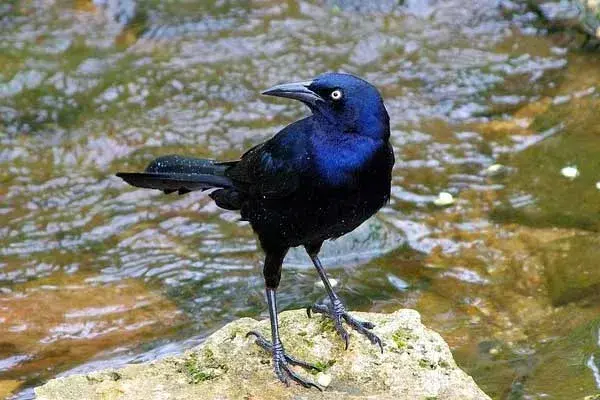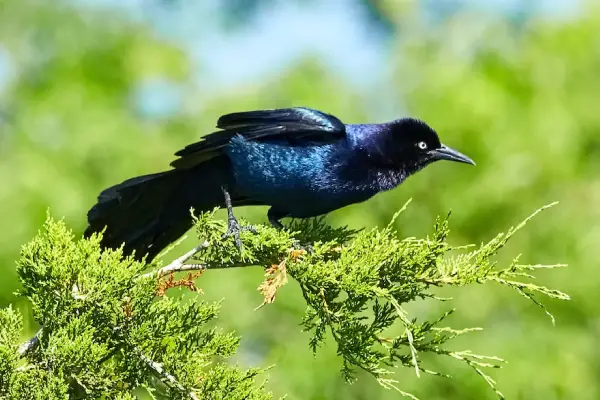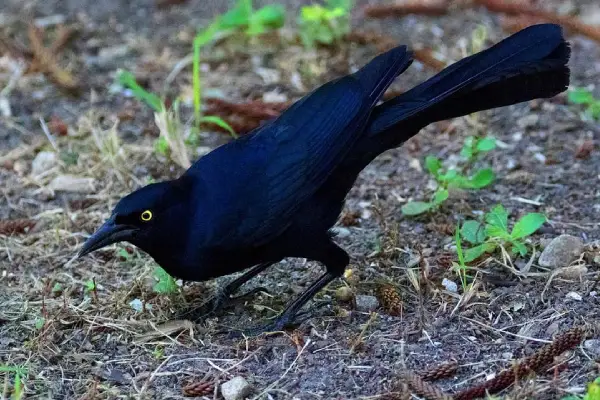If you’re looking for help to identify grackles in Texas, this will be the best article you read today.
In this post, you will find photos, identification info, calls and songs, and all the fun information you need.
Examples of Texas grackles include the Common grackle (Quiscalus quiscula), Boat-tailed grackle (Quiscalus major), and Great-tailed grackle (Quiscalus mexicanus).
Grackles have a bad reputation in Texas due to their aggressive food-snatching behavior, huge numbers, and overall bad omen-like looks.
Despite that, they are still very intelligent birds that belong to the New World blackbird family.
Here are their photos and fun facts.
Trivia Question: Can you guess how many bird species are in Texas?
Make sure to read until the end to see the answer.
Table of Contents
Grackles In Texas
Common Grackle

- Scientific Name: Quiscalus quiscula
- Lifespan: 17-22 years
- Wingspan: 14-18 in
- Length: 11-13 in
- Weight: 2.6-5.0 oz
- Range In Texas: Eastern Texas
Common grackles are one of the most widespread black birds with blue heads.
They are found throughout most of North America east of the Rocky Mountains and they inhabit woods, fields, farms, and urban areas.
Identify common grackles by their long, keel-shaped tails, dark beaks, and yellow eyes.
Males have glossy black plumage with a blue-green sheen on their heads; females are less iridescent and are mostly brown.
Common grackles are found in the eastern two-thirds of Texas, west through the High Plains and the central Edwards Plateau, and south to the Guadalupe River drainage.
They are permanent residents in eastern parts of the state and can be seen there year-round; some populations will spend winter in the eastern third of the state, typically from the middle of September until the end of March.
When the winter comes, common grackles will gather in flocks including millions of birds, often with other blackbird species.
These medium-sized backyard birds are classified as songbirds because they have all the vocal equipment of a songbird, not because they have beautiful songs.
Their song is a high-pitched rising “readle-eak” screech that sounds like a rusty gate opening.
Source: Jonathon Jongsma, CC BY-SA 3.0, via Wikimedia Commons
Some popular Texas dailies describe grackles’ songs as sounding like “everything from a squeaky door hinge and explosions of static from a radio left on at high volume to laughing whistles to monkey-like rattles.”
They can also mimic the sounds of other birds or even humans, although not as well as northern mockingbirds can, for example.
Common grackles are omnivores and feed on insects, minnows, frogs, eggs, berries, seeds, and grain.
To satisfy their diverse diet, they will forge in different places, from agricultural fields and feedlots to suburban neighborhoods, parks, city trashcans, and streets.
Lots of people have told the story of how grackles patiently wait for someone eating outside to turn their head away before the bird flies in to steal their favorite treat, the french fries.
It seems humans and grackles aren’t that different, after all.
A 2012 study by the National Audubon Society discovered that the common grackle population declined from the all-time high of 190 million in the 1970s to under 70 million today.
Such a 60% drop has resulted in the International Union for Conservation of Nature (IUCN) listing them as Near Threatened.
Common grackles breed in Texas from March to July, build their nests using twigs, leaves, and grasses, and place them high up in conifer trees near water.
They will have a clutch of 1-7 (usually 5) pale blue or green eggs that females incubate for 10-17 days.
Fun Fact: A group of grackles is called a “plague”.
They are just one of many songbirds that live in Texas. Read about other species on this link.
Boat-tailed Grackle

- Scientific Name: Quiscalus major
- Lifespan: up to 12 years
- Wingspan: 15-20 in
- Length: 15-17 in
- Weight: 5.8-8.8 oz
- Range In Texas: Along the Gulf Coast of Eastern Texas
Boat-tailed grackles are large blackbirds found on the coasts of Southeastern USA.
They inhabit coastal saltwater marshes and breed in saltmarshes, marshes along rivers, lakes, impoundments, or ponds, and in nearby upland habitats.
Identify male boat-tailed grackles by their iridescent black plumage, greenish-blue wings and keel-shaped tails, black downcurved beaks, and brown or yellow eyes.
Females have brown plumage, darker wings and tails, and pale brown breasts – they are almost two times smaller than males.
Boat-tailed grackles are permanent residents along the Gulf Coast of Texas, ranging from the Louisiana border southwest to the Rockport-Corpus Christi; some populations might only winter in that area.
They are a noisy species making several calls: quiet “chicks,” rough squeaks, rattles, chatter, and whistles. Their song consists of a series of loud “jeeb-jeeb” notes.
Source: G. McGrane, Public domain, via Wikimedia Commons
These gregarious birds are diurnal (active during the day) and gather in huge flocks to feed and roost.
They forage on the ground and have a diet consisting of small crabs, large insects, worms, seeds, grain, shrimps, frogs, turtles, and food they scavenge from humans.
Boat-tailed grackles will also steal food from other birds.
They are very aggressive during the breeding season and will chase away hawks and turkey vultures.
Males are polygamous, they mate with several females that build nests on their territories; females will also mate with male strangers from the colony.
Females build their nests using grass, twigs, moss, and feathers, over the water, and lay 3-5 pale blue eggs with dark spots. They incubate the eggs alone for 13-14 days and have 2-3 clutches a year.
Boat-tailed grackles breed in Texas from March to July and females provide all the care for the nestlings and fledglings.
According to some estimates, boat-tailed grackles have a global population of around 3.7 million birds and are listed as Least Concern by the IUCN.
On the Texas coast, their range overlaps with similar great-tailed grackles.
Great-tailed Grackle

- Scientific Name: Quiscalus mexicanus
- Lifespan: up to 22 years in the wild
- Wingspan: 19-23 in
- Length: 15-18 in
- Weight: 4.1-9.3 oz
- Range In Texas: Throughout Texas
Great-tailed grackles are the type of birds that Texans are most familiar with.
They are also known as Mexican grackles and are native to North and South America.
In the US, they are commonly found in central and southeastern parts.
Identify male great-tailed grackles by their iridescent black plumage with blue sheen on their heads and upperparts; females are brown.
Males also have large keel-shaped tails; female tails are not keeled and are smaller than in males.
Great-tailed grackles are permanent residents of Texas and can be seen in the state year-round, usually around pen woodlands, parks, and urban areas.
One 2010 study discovered that males are a lot glossier than females and that such glossiness correlates positively with tail length.
Great-tailed grackles sing multiple songs, ranging from sounding very sweet to sounding like a rusty gate hinge. Both sexes will also make low-pitched “chut” alarm calls.
Source: Niels Krabbe, CC BY-SA 4.0, via Wikimedia Commons
These black and blue birds begin breeding in Texas around mid-April and females lay 4-7 bluish eggs with brown spots.
They inhabit pastures, wetlands, and mangroves, feeding on insects, lizards, fruits, grains, worms, fish, and many other animals.
These highly intelligent and very social birds roost communally in groups ranging from several thousand to 500,000 birds!
Great-tailed grackles will nest in territories using 3 different strategies: they defend their territory with several females, they live in a colony but do not defend their territory, and they move from one colony to another after a few days.
Those males that form a territory are heavier and have longer tails than non-territorial ones.
As mentioned, great-tailed grackles resemble boat-tailed grackles; the two species were once grouped together under the name of “boat-tailed grackle.”
Great-tailed grackles are slightly bigger than boat-tailed ones and significantly larger than common grackles.
In Texas, most male great-tailed grackles have yellow eyes while boat-tailed grackles have brown eyes.
Habitat is another differentiating clue between them, great-tailed grackles inhabit open country with scattered trees while the boat-tailed grackles are common around salt and brackish marshes.
Females of these 3 species look alike – female great-tailed grackles will gather in colonial groups during the breeding season, while other grackles do not.
Unfortunately, due to the grackles’ habit of forming huge groups, Texas people are forced to endure these horror-movie-like scenes in their parking lots.
Fun Fact: In Austin, Texas, great-tailed grackles will gather around the city’s food trucks and try to snatch food – this has led many Austin natives to start referring to them as “taco raptors.”
Grackles also have a 3-star average on the Yelp page of the city of Austin, Texas – their rating is mostly made from 1 and 5-star reviews – you either love them or you hate them.
Trivia Question Answer: According to the Texas Bird Records Committee (TBRC) of the Texas Ornithological Society, as of June 2021, there are 655 species of birds found in Texas!
Read More: What species of grackles live in Florida?
Summary
This concludes our list of grackles found in Texas.
Examples include the common grackle, boat-tailed grackle, and the great-tailed grackle.
If you live in Texas, you must have noticed these omnipresent birds – hundreds and thousands of grackles judging Texas drivers while perched on power lines or hopping along their lawns or parking lots.
If you enjoyed our article, here are our other popular reads on birds: List of black birds that have long tails and List of grackles in Arizona